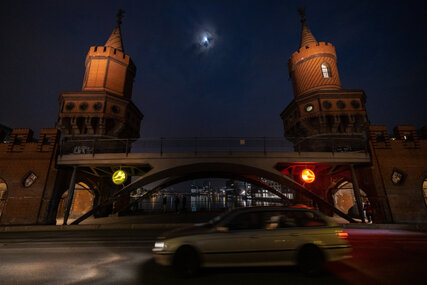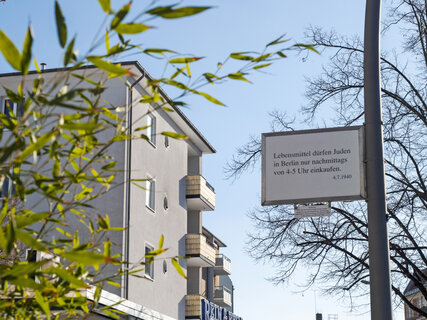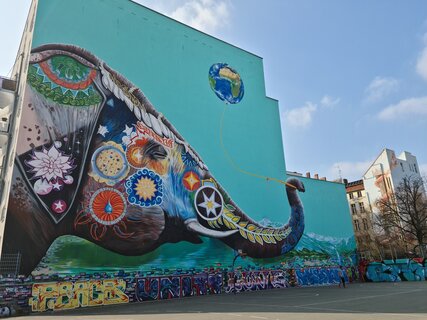
Enjoy a walk through Berlin and enjoy an open air exhibition visit at the same time. Berlin is the capital of sculptures - the whole city is a giant outdoor-museum: Statues from the imperial era, magnificent facades, impressive memorials and provocative sculptures of famous artists, you can discover everything in the capital. We introduce you to top 11 contemporary works of art in public space and give tips for a walk into the Berlin fall. Have fun strolling through the city!
Tip 1: Rock, Paper, Scissors

Every child knows the game "Rock, Paper, Scissors," which here at the Oberbaumbrücke artistically marks one of the former inner-city border crossings between East and West Berlin. In a six-second rhythm, the two round neon light displays change the hand signal. A symbol for the arbitrary decision of possible entry and exit. Every now and then, both displays switch to the outstretched hand for "paper," which seems a bit like offering to shake hands. Used as a crossing point for private citizens from 1971 to 1989. The best way to see the signs is to walk across the Oberbaumbrücke after dark.
Where: Oberbaumbrücke
Artist: Thorsten Goldberg
Walk: Along the Spree, for example past the East Side Gallery
Tip 2: Molecule Men

If you want to continue your walk along the East Side Gallery and across the Oberbaumbrücke, then stroll further in the direction of Arena Berlin and Badeschiff. Here you have a good view of the Molecule Men, one of the sculptures in public space that has long become an icon. The three 30-meter-high human figures stand right where Friedrichshain, Kreuzberg and Treptow meet. In addition, Jonathan Borofsy's Molecule Men aims to show "that both humans and molecules exist in a world of probability, and the goal of all creative and intellectual traditions is to find wholeness and unity within the world."
Where: An den Treptowers 1, Oberbaumbrücke
Artist: Jonathan Borofsky
Walk: continue along the Spree towards Treptower Park. Here you will find another gigantic work, the Soviet Memorial.
Tip 3: Sophie-Gips-Höfe: GG. Art.5

Article 5 of the German "Grundgesetz" secures freedom of the press, the right of information and to state your opinion. Artist Thomas Locher has immortalized this in old German letters on the façade of the ARD capital studio in courtyard 1 of the Sophie-Gips-Höfe. In addition to this work by Thomas Locher, you will find numerous other works of art in public spaces in the complex around the former sewing machine factory between Sophienstrasse and Gipsstrasse. Enjoy the relaxed and quiet atmosphere of the lovingly designed complex not far from the Hackesche Höfe.
Where: Courtyard 1 of the Sophie-Gips-Höfe
Artist: Thomas Locher
Walk: Take your time visiting the Sophie-Gips-Höfe, enjoy a coffee and let the atmosphere take its toll on you. Incidentally, the Hoffmann couple, who were responsible for the development of the courtyards, have set up a gallery for their private art collection in the attics of courtyard 2. You can visit it on Saturdays by appointment (030-28 499 120).
Tip 4: Berlin Junction

Not entirely without controversy is this enormous sculpture made of two steel plates, with which Richard Serra wants to make space itself tangible. Thus, the narrow, threatening space stands between the two curved, curved plates. Walk through it once, it feels almost threatening and oppressive. Contrast this with the empty expanse of the square in front of the Philharmonie. It was from here that the Nazis launched their euthanasia program. The sculpture is also controversial because many would have considered a memorial more fitting than the raw monumentality of the steel plates. Meanwhile, nearby, you'll also find a memorial and information site for the victims of the Nazi "euthanasia" murders.
Where: in front of the Philharmonie, Herbert-von-Karajan-Straße
Artist: Richard Serra
Walk: Stroll from here along the concrete surfaces and stairs of the Kulturforum. The Tiergarten is also not far away. Here is another memorial: the Memorial to Homosexuals Persecuted under National Socialism.
Tip 5: Windspiegelwand (Wind mirror wall)

If you're at the Kulturforum, take a stroll to the Landwehrkanal and then along the Reichpietschufer in the direction of Potsdamer Platz. At the GIZ building, Olafur Eliason's wind mirror wall shows how a little life can be conjured up on gray facades with almost playful simplicity. The mirror plates are installed in such a way that they follow the course of walls and stairs in the building, but can be easily moved in their position by the wind. Thus, depending on the wind and weather, the sky, clouds, trees and surroundings are reflected in the reflective platelets. A poetic addition to the urban landscape.
Where: three partial facades of the GIZ (Gesellschaft für Internationale Zusammenarbeit), rear side of Reichpietschufer 20
Artist: Olafur Eliasson
Walk: In a few minutes you can be in Gleisdreieckpark from here. Or you can walk past the Kulturforum, the Philharmonie and the Serra sculpture "Berlin Junction" into the Tiergarten.
Tip 6: Hand with clock

As a popular meeting place for the students of the Gymnasium Tiergarten, the bronze hand with clock has already received some cosmetic embellishments. Nail polish or even graffiti tags. First erected in 1975, the hand with clock still had to be refurbished. The digital display at the top of the cut wrist reminds the students when it's time to go back to class - and at the same time it makes us think, as it carefully grips the orange cuboid.
What chances and opportunities do we seize as time passes? The answer is provided by Depeche Mode. Everything Counts is the title of the song, in whose video clip the hand with the clock plays a small role. For the artist, Joachim Schmettau, the hand with a clock was the first sculpture in public space. His most famous work is the globe fountain at Breitscheidplatz.
Where: Altonaer Street / Lessing Street
Artist: Joachim Schmettau
Walk: You can either walk down Altonaer Straße towards the Spree River or walk in the opposite direction English Garden, Bellevue Palace, Victory Column and Great Tiergarten.
Tip 7: Tower and Wall

Not far from Jannowitzbrücke, Peter Kirkeby's brick wall stretches over a length of 100 meters. It is a kind of demarcation between the combined heat and power plant and the Spree River, but also allows an unobstructed view through the many openings in the lower section and invites visitors to slalom back and forth between the two areas. A trained natural scientist, Kirkeby devoted himself to painting for a long time, also participating in happenings in the 1960s and working with artists such as Joseph Beuys and Nam June Paik. In his clinker building sculptures, he cites architectural features from around the world.
Where: Köpenickerstr. 60/Michaelkirchstr.
Artist: Per Kirkeby
Walk: You can get to the Spree quickly from here. If you walk across Jannowitzbrücke and then along Rolandufer into the city center, you'll be at Berlin Cathedral in half an hour.
Tip 8: Botschaften. (Messages)

For the messages, Silvia Klara Breitwieser asked a total of 30 contemporary museums in East and West for their assessment of the situation and future of art. If you follow the messages, they will lead you around the Berlinische Galerie to the Jewish Museum. On the front of the signs you can read the message, on the back who formulated it. Tip: In the Bavarian Quarter (Bayerisches Viertel), you will also find messages attached to the street lighting poles. These "Places of Remembrance" (Orte des Erinnerns) by Renata Stih and Frieder Schnock commemorate the discrimination and disenfranchisement of Berlin's Jews.
Where: Alte Jakobstraße, Am Berlin Museum, Lindenstraße
Artist: Silvia Klara Breitwieser
Walk: Just follow the messages.
Tip 9: Two concrete Cadillacs in the shape of Naked Maja

For this sculpture on the outer western edge of the Ku'damm, the artist, Wolf Vostell is even said to have received death threats. In fact, the two Cadillacs cast in reinforced concrete were hated by most Berliners. So was the entire sculpture bouleverad commissioned in 1987 to celebrate the 750th anniversary of the city. Seven artworks and sculptures were realized with the budget of 1.8 million marks. Originally intended as a temporary promenade, the works are now a part of Berlin to which people have then become accustomed, despite all the protests.
Where: Rathenauplatz
Artist: Wolf Vostell
Walk: Just walk along Ku'damm towards Breitscheidplatz and keep your eyes open for more sculptures while window shopping.
Tip 10: Structure

Very close to the Museum of Technology you will find "Structure" by Sol LeWitt. How many cubes do you see? To be honest, we didn't count them, but if you're a bit fit in mathematics, you can certainly calculate this quite quickly. The artwork is composed of five times five white painted aluminum cubes, which merge into each other in the play of light and shadow in different patterns. So despite the bare geometry, it's a visual feast for the eyes. Incidentally, Sol LeWit designed his cube based on the construction plans for the family court in front of whose facade it stands.
Where: Hallesches Ufer 62
Artist: Sol LeWit
Walk: From here, you'll quickly be on the grounds of the Museum of Technology and the adjoining Gleisdreieck Park.
Tip 11: Pyramid on the TU grounds

The pyramid is just one of a total of 80 works of art and sculptures that you can visit on the TU grounds. Not all of them are as well hidden as this architectural climbing frame next to the Institute of Aerospace Engineering. In summer, all sides are overgrown with green plants. The best-known work of art by the architectural firm Haus Rucker & Co is the 1977 frame building for documenta 6 in Kassel, which still frames the view of the Karlsaue city park.
Where: North grounds of the TU/Straße des 17. Juni
Artist: Hans-Rucker-Co
Walk: Take some time to explore some of the other sculptures on the grounds, including Karl Friedrich Schinkel's Ionic Column, Johann Heinrich Strack's Arcade Hall, and monuments to notable figures such as Werner von Siemens and Franz Reuleaux.
ABOUT BERLIN App:

You want to discover even more art in public space. Then get our free ABOUT BERLIN app with a great special on Urban Art | Street Art. Where can you find the most beautiful murals in Berlin? What are the stories behind the murals? In addition to several street art tours including directions, you'll find videos and interpretive audio books on numerous murals. Immerse yourself in Berlin's street art scene. Download now for free for iPhone and Android.


There are many stories to tell. ABOUT BERLIN.
Tip and thank you: In the art guide "Marmor für alle. Zur Kunst im öffentlichen Raum in Berlin" by Jörg Johnen you will find more inspiration for walks to artworks in public space.






